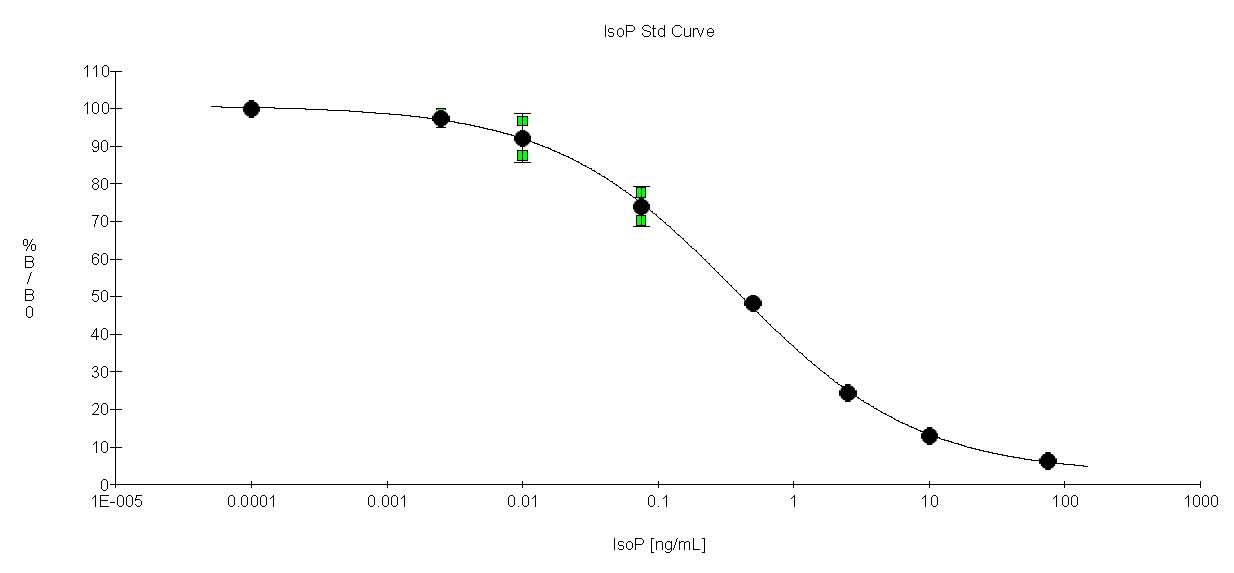Product Overview
Background
Isoprostanes are a group of prostaglandin-like compounds that are produced by the reaction of free radicals with arachidonic acid, including arachidonic esters in phospholipids. Initially reported by Roberts and Morrow as major products of radical mediated lipid oxidation in vivo, they are now widely recognized as reliable biomarkers for oxidative stress. Isoprostane is present in numerous biological fluids including urine, saliva, cell lysates, and blood. In urine, an average of 50% of isoprostane is excreted as a glucuronide so it is important to pre-treat samples with glucuronidase prior to assay. Oxford's ELISA includes glucuronidase as well as a specially formulated buffer allowing direct measurement of isoprostane without the need for expensive SepPaks or immunoaffinity columns. This brings the cost per sample down to 20% of what competing assays cost to run and a fraction of the technician time. This extraction free assay can be used with urine, saliva, and other simple mixtures. Plasma, serum, and cell lysates should be assayed using our EA84 EIA kit
For additional information regarding isoprostane analyses, the influence of isoprostane metabolism, and complete references, see our White Paper.
Assay Principle
This kit is a competitive enzyme-linked immunoassay (ELISA) for determining levels of 15-F2t-Isoprostane (the best-characterized isoprostane) in urine samples. Briefly, urine samples are mixed with an enhanced dilution buffer that essentially eliminates interference due to non-specific binding. The 15-F2t-Isoprostane in the samples or standards competes with 15-F2t-Isoprostane conjugated to horseradish peroxidase (HRP) for binding to a polyclonal antibody specific for 15-F2t-Isoprostane coated on the microplate. The HRP activity results in color development when substrate is added, with the intensity of the color proportional to the amount of 15-F2t-Isoprostane-HRP bound and inversely proportional to the amount of unconjugated 15-F2t-Isoprostane in the samples or standards.
Typical Standard Curve

Recommended Product
When using urine as a sample, it is recommended to run our Creatinine Assay Kit (CR01) in conjunction with your samples since urinary creatinine levels may be used to normalize the rate of excretion of other analytes.
Recommended References
1. Morrow, J., Harris, T., & Roberts, L., Anal. Biochem. 14:1-10 (1990).
2. Morrow, J. D., Hill, K. , Burke, R. F., Nammour, T. M., Badr, K. F., and Roberts, L. J., Proc. Natl. Acad. Sci. U.S.A. 87:9383-9387 (1990).
3. Morrow, et. al., The Isoprostanes: Unique Bioactive Products of Lipid Peroxidation. Prog. Lipid Res. 36:1-21, 1997.
4. Morrow, J., Awad, J. A., Boss, H. J., Blair, I. A., and Roberts, L. J., Proc. Natl Acad. Sci USA 89:10721-10725 (1992).
5. Wang, et al., Immunological characterization of urinary 8-epi-prostaglandin F2a excretion in man. J. Pharm. Exp. Ther. 275:94-100 (1995).
6. Morrow, J., Zackert, W., Yang, J., Kuhrts, E., Callewaert, D., Taber, D., Oates, J., Roberts, J., Quantitiation of the major urinary metabolite of the isoprostane 15-F2t-Isoprostane(8-iso-PGF2a) by a stable isotope dilution mass spectrometric assay, Analytical Biochem. 269: 326-331 (1999).
7. Roberts II, L.J., Morrow, J.D., Measurement of F2-isoprostanes as an index of oxidative stress in vivo, Free Radic. Biol. Med. 28:505-513 (2000).
